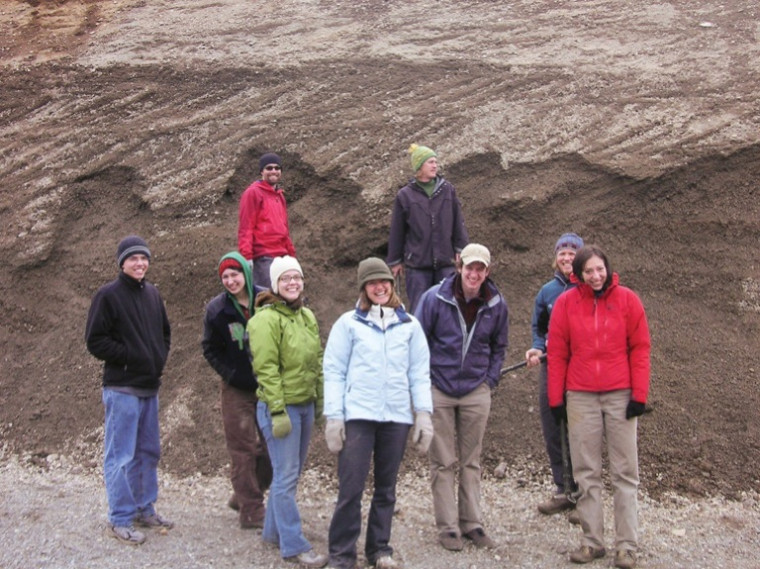Looking for Landslides
Open gallery

Tourists visit Eastern Oregon to raft scenic river canyons, find fossils in ancient volcanic deposits, and enjoy breathtaking vistas of deserts and mountains.
Geologists like Liz Safran study Eastern Oregon for the same basic reasons. The hubbub of geological activity that produced stunning panoramas and unique recreational opportunities also spawned an ideal laboratory for scientists seeking to better understand the forces that shape the earth’s evolution.
Last semester, Liz Safran brought Eastern Oregon into her classroom–and took her students into Eastern Oregon–to examine where and why landslides occur. Her goal: to introduce them to spatial analysis, an oft-used tool in the environmental scientist’s toolbox, and give them a taste of “what it’s like to plunge into the unknown and contribute something new to science.”
And contribute they did. By semester’s end, students had literally dug up information that is helping Safran and her colleagues unravel the mystery of geologic change across the high desert of the interior West. “They began to pull on threads,” she says.
Safran is a geomorphologist, an earth scientist who studies how landscapes evolve. These days, in her sixth year as associate professor of geological science at Lewis & Clark, she is particularly fascinated by how massive lava flows, earth-jolting landslides, and other “high-magnitude events” interrupt the slow, steady work of rivers carving their way through bedrock.
Safran’s interest is shared by a growing number of scientists. The rate at which rivers erode their channels is increasingly recognized as a factor in a wide variety of environmental phenomena, from the emergence of mountain ranges to the chemical composition of oceans.
Oregon’s vast high-desert region, east of the Cascade Mountains, offers a near-perfect setting for geological fieldwork. The rivers there are fed sparingly by rainfall, can’t gather much power due to the flat topography, and meander through a largely unpeopled region. As a result, landslides are easier to identify, and the blockages they create are likely to have a big impact.
Eleven students in Safran’s 200-level Spatial Problems in Geology class were given the task of mapping the locations of landslides and identifying the rocks surrounding them. Research indicates that landslides tend to occur near the contacts between certain rock types.
To complete the assignment, students needed to learn spatial analysis. It’s a skill often associated with Geographic information Systems (GIS) software, which manages and displays a series of location-based data. In this case, says Aaron Vandenberg ‘06, “GIS allowed us to reduce 100,000 square kilometers into a computer file, visually display the information, and use it in the classroom.”
Students downloaded topographical maps of five watersheds from the U.S. Geological Survey’s website, transferred them into the GIS software, and marked more than a hundred landslides. (They’re fairly easy to spot because of the telltale semicircular impressions they leave behind.) Next, they overlaid another map–this one denoting which rock types lay exposed at the earth’s surface.
With the help of GIS software, students were able to determine which rock types occur most frequently around landslides and to stretch or shrink the sample area around each landslide to test various hypotheses.
“Spatial analysis is very important to geology because the processes we study occur so slowly or infrequently that we don’t get to see the action,” says Safran. “Instead of time-based patterns, we rely on spatial patterns to figure out what’s happening. GIS helps us do that.”
Two field trips, one to the Columbia River Gorge and the other to the Deschutes River, balanced the course’s sometimes intense and challenging computer work. (See related article at right.)
In final group projects, the students employed their new GIS skills on questions of their own choosing. Each group produced a poster on its discoveries. Vandenberg and Megan Taylor ‘07 pursued the question of whether landslides significantly alter the slope of canyons in river tributaries. (Some do and some don’t, they found.)
Taylor, an environmental studies major who wants to restore rivers to health, says she learned a marketable skill in GIS, as well as what it’s like to perform and present original research. “Professor Safran taught us not only how to analyze a question, but also how to communicate our findings, which is essential for a scientist.”
Safran says students made headway in understanding channel erosion in the same manner that any scientist advances his or her field of study–by “nibbling away at the edges” of a problem. The process sounds a lot like the age-old struggle between river and rock.
by Dan Sadowsky
More L&C Magazine Stories
Lewis & Clark Magazine is located in McAfee on the Undergraduate Campus.
MSC: 19
email magazine@lclark.edu
voice 503-768-7970
fax 503-768-7969
The L&C Magazine staff welcomes letters and emails from readers about topics covered in the magazine. Correspondence must include your name and location and may be edited.
Lewis & Clark Magazine
Lewis & Clark
615 S. Palatine Hill Road MSC 19
Portland OR 97219

